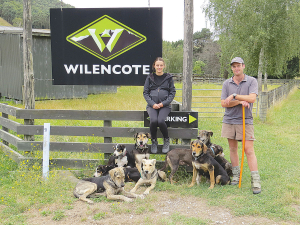Focus group shares farmer problems, finds answers
Fraser Tombleson reckons that being part of a focus group for the Hill Country Futures Partnership programme was a good opportunity to express shared problems and concerns.
 Matt and Megan Humphreys were part of a farmer focus group which provided insights that helped develop FarmSalus.
Matt and Megan Humphreys were part of a farmer focus group which provided insights that helped develop FarmSalus.
Gisborne farming couple Matt and Megan Humphreys have helped shape the development of a farmer wellbeing assessment tool.
The Humphreys, who farm 420 hectares at Ngatapa, were part of a farmer focus group which provided insights that helped develop Farm- Salus as part of the Hill Country Futures Partnership Programme.
“It is great to see a holistic focus on supporting hill country farmers with initiatives like the Hill Country Futures Partnership Programme,” says Matt.
Alongside scientific research, the programme includes a focus on telling the real stories about hill country farming – and the couple see that as a key factor.
“It is so important to build understanding about how hill country red meat is produced in New Zealand compared to the rest of the world,” says Megan.
“The industry needs to be better understood and future proofed. Objective research detailing how red meat is produced can feed into policy decision making and marketing, ensuring the media are told accurate information around hill country farming – and hopefully our products receive a premium to reflect the way it has been grown.”
The $8.1m programme is focused on future proofing the profitability, sustainability and wellbeing of New Zealand’s hill country farmers, their farm systems, the environment and rural communities. It differs from most pastoralbased research, in that it considers the whole-farm system and, critically, the wider communities these systems exist within.
It incorporates traditional science research, farmer knowledge, social research and citizen science and has a strong emphasis on forages and providing decision-making tools to help farmers select the best forage option for different land management units.
FarmSalus was developed with input from the focus group, and from an analysis of 170 face-toface interviews carried out by the Hill Country Futures social research team with almost 300 farmers, rural professionals, academics and industry leaders throughout New Zealand.
Ange McFetridge, design and capability lead for B+LNZ, says members of the focus group played an important part in the development of Farm- Salus.
“We wanted to interview a group who were representative of people living in hill country, to help us to future proof our work,” she explains.
“We put out a request to the farming community and got the group together. We had a faceto- face meeting with them and got a whole lot of insights about their frustrations and their aspirations for the future for their farms.”
McFetridge says what’s good is that they have continued as a group and are very free and frank with one another.
“They all know about working through succession, and the environment, stewardship and business health are all very important for them.”
She and her team also held a second meeting with the focus group.
“We wanted to show them what we had done with their insights and to test some of the conceptual work and deliverables to gain their feedback on the utility of that,” McFetridge explains. “It was important for us to validate that we were on the right track and ensure hill country farmers had an active voice in what we were doing.”
Committed To Hill Country Farming
The Humphreys family’s roots run deep in the region.
Matt is the fifth generation to farm Herefords and the fourth generation at their Wilencote stud; his ancestors started out at Strahallan Station in Gisborne. Wilencote is New Zealand’s oldest Polled Hereford stud – and the family introduced the hornless Hereford breed to New Zealand in the 1920s.
Megan has an environmental consultancy background, while Matt has wideranging experience in hill country farming.
Wilencote has 300 registered Hereford breeding cows, including heifers. Some trading lambs have recently been introduced into the system but the stud is the key focus for the farm. The Humphreys sell around 30 bulls each year, many to local farmers. Their programme is focused on breeding bulls that have good structure, temperament, mobility and a certain ‘athleticism’, ensuring progeny have quality carcass traits.
“Our breeding philosophy is about small, steady and incremental improvement – optimising and balancing traits within the herd,” Matt explains.
"We have been working away at implementing a new stud recording system, rolling out DNA testing across the herd and have some ambitious environmental goals, including natural bush regeneration and wetland enhancement projects.”
Federated Farmers says almost 2000 farmers have signed a petition launched this month to urge the Government to step in and provide certainty while the badly broken resource consent system is fixed.
Zespri’s counter-seasonal Zespri Global Supply (ZGS) programme is underway with approximately 33 million trays, or 118,800 tonnes, expected this year from orchards throughout France, Italy, Greece, Korea, and Japan.
Animal owners can help protect life-saving antibiotics from resistant bacteria by keeping their animals healthy, says the New Zealand Veterinary Association.
According to analysis by the Meat Industry Association (MIA), New Zealand red meat exports reached $827 million in October, a 27% increase on the same period last year.
The black and white coat of Holstein- Friesian cows is globally recognised as a symbol of dairy farming and a defining trait of domestic cattle. But until recently, scientists didn’t know which genes were responsible for the Holstein’s spots.
According to the New Zealand Dairy Statistics 2024/25 report, New Zealand dairy farmers are achieving more with fewer cows.